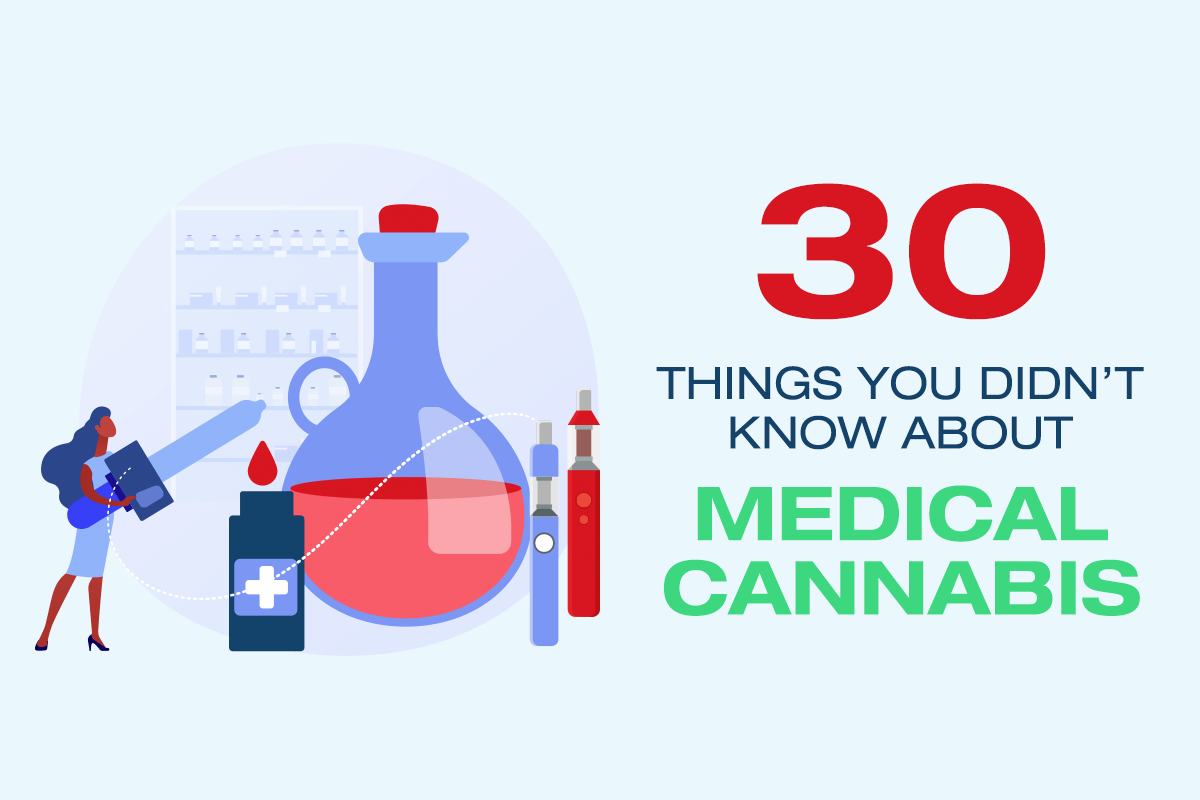30 THINGS YOU DIDN’T KNOW ABOUT MEDICAL CANNABIS
As medical research uncovers more evidence of medical cannabis’ benefits in treating a range of complaints, we thought it might be interesting to present a collection of fascinating facts about the plant, its history and its amazing properties. How many of these did you already know?
30 THINGS YOU DIDN’T KNOW ABOUT MEDICAL CANNABIS
As medical research uncovers more evidence of medical cannabis’ benefits in treating a range of complaints, we thought it might be interesting to present a collection of fascinating facts about the plant, its history and its amazing properties. How many of these did you already know?
- The earliest written accounts of cannabis being used as a medicine are found in ancient China, 4,700 years ago during the reign of Emperor Shen Nung.
- The Cannabis sativa plant grows wild in many tropical and humid parts of the world. Its seeds have been used for animal feed, its fibres for hemp rope and its oil an ingredient in paint.
- Medical cannabis has been shown to be an effective substitute for addictive opioids, helping pain sufferers cease or reduce their opioid use while still effectively treating symptoms.
- People using vaping devices to inhale their medical cannabis treatment will feel the effect begin after a few minutes and reach a peak after 10–30 minutes. The effect will typically continue for around two hours, depending on the formulation, the illness and the patient.
- Physician-prescribed cannabis extracts and tinctures for medical and therapeutic purposes became legal in the Cayman Islands in 2017.
- Ancient Greek historian Herodotus reported that the Scythians threw hemp seed on to red-hot stones, producing a vapour that delighted them and made them shout for joy!
- Cannabis exists as separate male and female plants. Male plants are taller and thinner, while the female plant is darker and shorter and has hairs protruding from its pods. The unpollinated female produces up to 20x more medicinal compounds in its resin.
- The endocannabinoid system is a complex cell signalling system in the human body that was identified in the early 1990s by researchers studying THC in cannabis. The system is comprised of specialised receptor sites that regulate your body’s reaction to fatigue, hunger, stress, anxiety and pain.
- Medical cannabis is currently legal in 33 US states and in the District of Columbia. Thirty countries have so far legalised the use of cannabis for medical purposes.
- A German medical study revealed that 54% of Parkinson’s sufferers reported a beneficial clinical effect from using cannabinoids. Over 40% of users reported that it helped manage pain and muscle cramps, while more than 20% of users reported a reduction of stiffness.
- The cannabis plant contains over 500 compounds, but the main biologically-active ones are phytocannabinoids such as CBD, THC, CBC, CBD, CBDV and CBN, and terpenoids, which are the aromatic constituents of essential oils also found in spices, fruits and vegetables.
- In 2018, the US Food and Drug Administration approved an isolated form of the cannabinoid CBD (Epidiolex) to treat two rare and severe types of epilepsy that do not respond well to other treatments.
- Vaping pharmaceutical-grade medical cannabis is preferred over smoking cannabis because the combustion from smoking produces acrid fumes and toxic chemicals that can be harmful to health. Conversely, vaping warms (but does not burn) the cannabis extract, releasing gentle vapour that can be directly inhaled into the lungs and directly enters your bloodstream.
- Medical cannabis users report less pain, better sleep, reduced anxiety, less need for healthcare resources and an overall better quality of life according to Johns Hopkins Medicine.
- Early Arabic texts referred to the cannabis plant as the “bush of understanding” and the “morsel of thought.” Thirteenth-century Sufi Muslims used it as part of their religious practices.
- Medical cannabis may help to reduce blood pressure in older adults, according to researchers from Ben-Gurion University (BGU) of the Negev.
- A recent study showed that it is safe to drive while taking low doses of the cannabinoid CBD, which is non-psychoactive. (Note: THC, however, may affect perception and response-times while driving.)
- Vaping medical cannabis increases bioavailability by 95% – 10x faster than ingested oils, which must first be metabolised through the intestines and filtered by the liver. ‘Bioavailability’ is the rate at which cannabinoid compounds enter the bloodstream.
- The US Center for Disease Control (CDC) has no category for cannabis deaths, as no lethal dose has ever been reported. It is estimated that a 150-pound adult would need to take 5,000x the normal dose of THC to overdose fatally.
- Medical cannabis has been shown to reduce alcohol consumption among 44% of participants in one Canadian study.
- Dementia patients with neuropsychiatric symptoms and food refusal issues have benefitted from medical cannabis, enjoying reduced agitation, more sleep and healthy weight gain.
- There are two main strains of cannabis plant: sativa and indica. The former has slender, lighter coloured leaves while indica has broader, darker leaves. Sativa contains higher levels of THC, but indica has more CBD. Hybrid strains create the best of both plants.
- Harvard’s Marijuana Investigations for Neuroscientific Discovery (MIND) program found that a group of people using medical cannabis for anxiety, chronic pain and sleep problems, also improved skills such as paying attention and managing time.
- Besides THC and CBD, around 140 other cannabinoids have been identified. Meanwhile, there are over 100 terpenoids found in a single plant. Each has its own unique impact on the body. Specific compounds can be extracted and mixed together to treat specific medical issues.
- There is strong evidence that medical cannabis is effective for the treatment of chronic pain, chemotherapy-induced nausea and vomiting and multiple sclerosis spasticity symptoms, according to the National Academies of Sciences, Engineering, and Medicine. Further evidence points to its effectiveness in improving short-term sleep outcomes and fibromyalgia symptoms.
- Cannabinoids from the cannabis plant (i.e. phytocannabinoids) can boost the body’s natural endocannabinoid system. They fit receptor sites like a key in a lock and supplement what the body may be missing.
- Cannabis flowers appear to be covered in small crystals that look like frost. These are called trichomes and function as tiny resin glands that hold compounds such as CBD and THC.
- Medical cannabis is currently being used in the US to treat post-traumatic stress disorder, cancer, cachexia, glaucoma, HIV/AIDS and degenerative neurological conditions.
- Research shows that CBD deters human breast cancer cell proliferation and invasion.
- Research by the American Alliance for Medical Cannabis (AAMC) suggests that medical cannabis can help diabetes sufferers by stabilising blood sugars and suppressing the arterial inflammation.
Take the Cannabis Quiz if you want to learn more about specific blends and determine if you could benefit from medical treatment.

